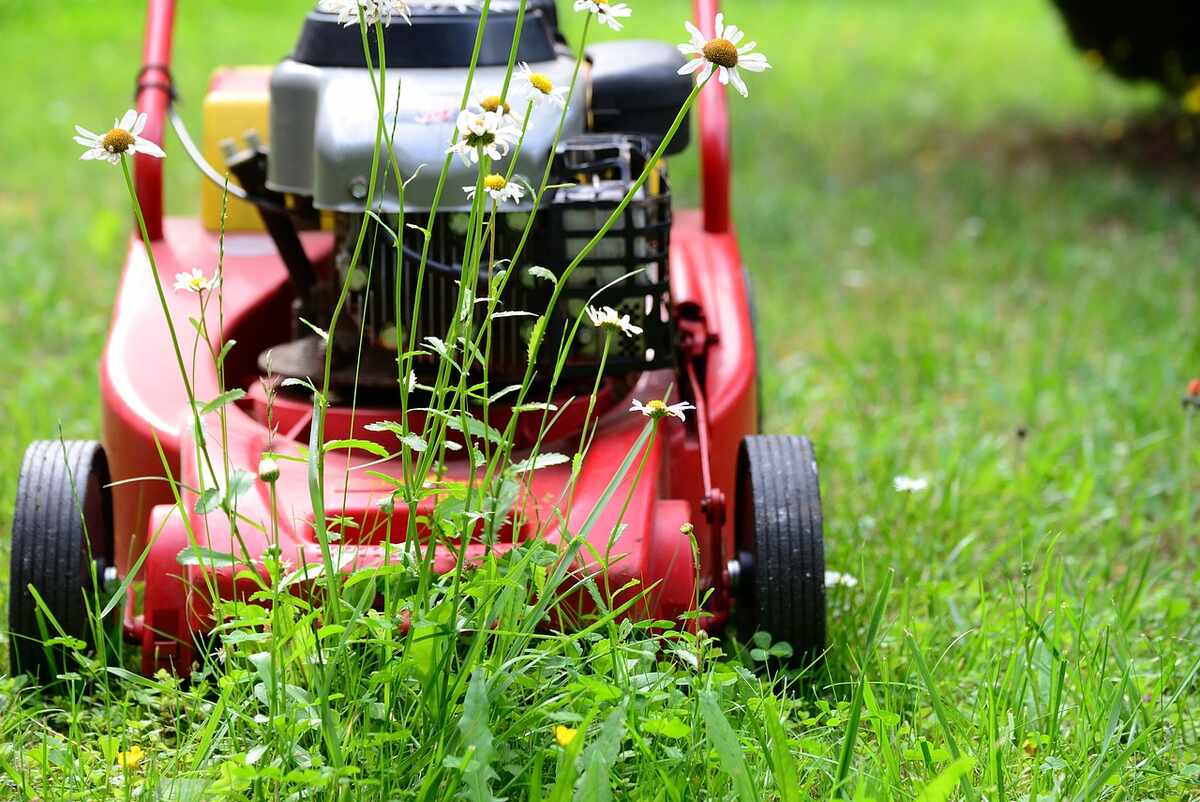
Mowing and fertilization are essential aspects of lawn care during your grass’s growing season, and the time to do both can sometimes overlap. Although it’s tempting to mow and fertilize on the same day to save time, it’s far better to mow a few days before fertilizing. However, you can mow and fertilize on the same day if you do it correctly.
This guide will walk you through the DO’s and DON’T’s of mowing and fertilizing at the same time so you won’t harm your grass.
When to Mow and Fertilize
You know you need to mow and fertilize your lawn during its growing season, but when should you do one, and when should you do the other? When can you mow after fertilizing or vice-versa? Let’s look at a few possible mowing/fertilizing schedules and their pros and cons:
- OK: Mowing and Fertilizing on the Same Day
- BEST: Mowing a Few Days Before Fertilization
- OK: Mowing a Few Days After Fertilization
- WORST: Mowing Directly After Fertilization
OK: Mowing and Fertilizing on the Same Day
Although we mentioned before that mowing and fertilizing on the same day isn’t the best idea, it can be done. You just have to be careful about the order: Don’t cut your grass after the fertilizer application; instead, always mow before fertilizing if you want to do both on the same day. Here’s why:
- Mowing the lawn before fertilization on the same day helps the fertilizer spread more evenly.
- Mowing doesn’t just make your lawn neater; it also removes debris like fallen leaves. This, consequently, helps your fertilizer reach the soil much easier.
- Lastly, mowing your lawn directly before fertilization means that you don’t have to worry about mowing your lawn again until a week later.
However, mowing and fertilizing your lawn on the same day has its disadvantages. If you’re not bagging your grass clippings, you have to make sure that they’re spread evenly on your lawn, or else your fertilizer may not reach the soil in some spots, resulting in patchy growth.
Doing both tasks back-to-back can also take up your whole day, especially since you’ll want to wait for a little while after mowing before you apply fertilizer to avoid burning the freshly cut grass tips.
| Pros | Cons |
| ✓ Allows for a more even spread of fertilizer ✓ Removes debris and growth that can block fertilizer ✓ Grass clippings can be left on the lawn as additional fertilizer ✓Gets mowing out of the way for the current week ✓ Allows grass to absorb fertilizer undisturbed | ✗ Lawn clippings can block fertilizer if not spread out properly ✗ More time-consuming ✗ Have to wait for a while to fertilize or risk nitrogen burn on your grass tips |
BEST: Mowing a Few Days Before Fertilization
Instead of mowing and fertilizing on the same day, as a general rule, the best option is to mow your lawn a few days before or the day before fertilization.
The benefits of mowing a few days before fertilizing are the same as mowing right before fertilizing: more even application, easier soil penetration, better absorption, and so on. Plus, you don’t need to worry about nitrogen burn if you wait to fertilize until a few days after you mow.
However, this requires you to allot time for lawn care over two separate days instead of just one – although you’ll only need to fertilize the lawn two to four times per year. Also, you still have to be careful about spreading your grass clippings, as they won’t totally decompose in just a few days.
To further understand why this option is better, check out our article Why and When Should You Mow Before Fertilizing Your Lawn?
| Pros | Cons |
| ✓ Allows for a more even spread of fertilizer ✓ Grass clippings can be left on the lawn as additional fertilizer ✓ Gets mowing out of the way for the current week ✓ Allows grass to absorb fertilizer undisturbed ✓ Less risk of fertilizer burn on your turf’s blade tips | ✗ Lawn clippings can block fertilizer if not spread out properly ✗ Time to mow and fertilize needs to be allotted over two separate days ✗ You may need to clear your lawn of debris again before fertilization |
OK: Mowing a Few Days After Fertilization
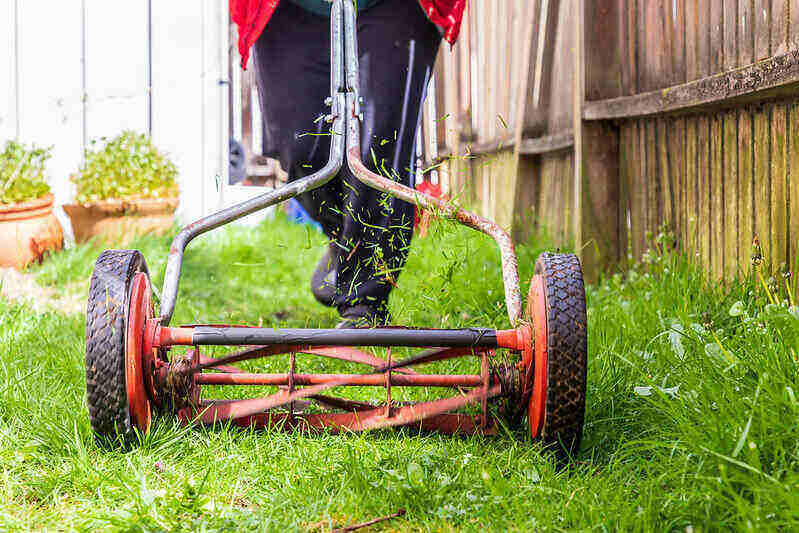
As an alternative to mowing before fertilization, you can mow after fertilizing. You’ll just have to wait a few days. Many of the perks of mowing before fertilization also apply to mowing a few days after fertilization, but there are more drawbacks.
You need to wait to mow your lawn after fertilizing it, but how long? About 24 to 48 hours is the ideal amount of time, but you might need to wait even longer before you can cut grass after fertilizing. Depending on when you last mowed, you may have to let your grass grow rather long before you can mow it again.
Besides that, you still need to schedule two days out of the week for lawn care, and you’ll have to clear out debris from your lawn before fertilizing it.
| Pros | Cons |
| ✓ Allows for a more even spread of fertilizer ✓ Grass clippings can be left on the lawn as additional fertilizer ✓ Smaller risk for fertilizer to burn your turf’s blade tips | ✗ Time to mow and fertilize needs to be allotted over two separate days ✗ You may need to clear your lawn of debris before fertilization ✗ You need to wait at least 24 to 48 hours before mowing after fertilization, which means your grass can grow rather long, depending on when you last mowed it |
WORST: Mowing Directly After Fertilization
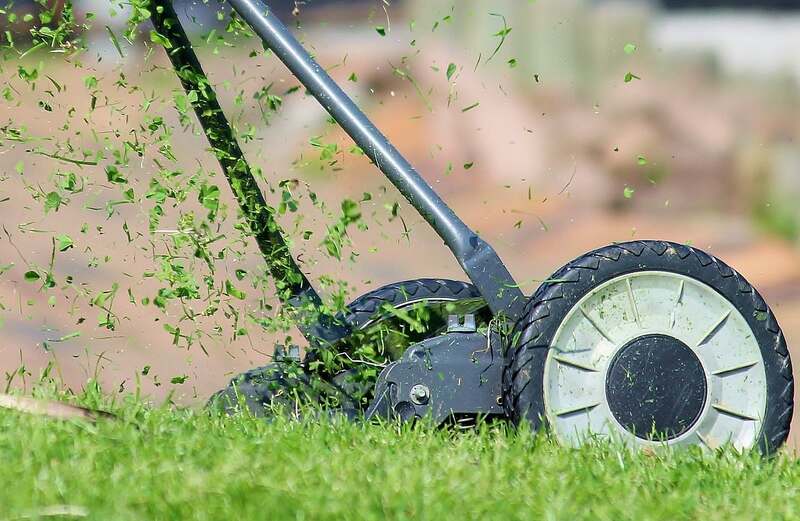
Cutting grass directly after fertilizing (as in, on the same day) is the worst order for these two lawn care procedures. There are two different situations you might experience, but the outcome is relatively the same: wasted time, effort, and money.
Most fertilizers need to be watered in so that they can reach the soil. In that case, mowing directly after fertilization means you’ll be mowing wet grass, which results in a sloppy and uneven cut. Aside from that, you may cut away the part of the grass blade that the fertilizer has stuck to.
This results in uneven fertilizer application, especially if you use a grass catcher with your lawn mower. Some parts of your lawn won’t get all the benefits the fertilizer would’ve provided, and some parts won’t get any fertilizer at all. Do you want a patchy, uneven lawn? This is how you can get one.
| Pros | Cons |
| ✓ Less time-consuming | ✗ Redistribution and/or stripping of fertilizer from your lawn ✗ Can result in a patchy, uneven lawn from mowing wet grass, uneven fertilizer application, or both ✗ Wasted money, time, and effort |
There is one way for you to mow your lawn after fertilizing on the same day that might not end in disaster. If you use a liquid fertilizer, you could mow your lawn in as little as four hours after the fertilizer has dried. However, liquid fertilizer is more expensive and not as consistent as granular fertilizer.
How to Mow and Fertilize on the Same Day
If you want to mow and fertilize on the same day, you can follow this step-by-step guide to do it right, with the least risk of damaging your lawn:
- Step 1: Check the Weather
- Step 2: Clean Your Lawn
- Step 3: Mow Your Lawn
- Step 4: Rake Any Grass Clumps
- Step 5: Fertilize Your Turf
Step 1: Check the Weather
You don’t want to schedule these tasks before heavy rain, as the fertilizer can be washed away. Always check the weather forecast for the next few days before bringing out your fertilizer and starting up your lawn mower.
You also don’t want to mow and fertilize when it’s too hot out or if there’s a prolonged drought going on. You could risk stressing out your turf and burning your lawn.
Step 2: Clean Your Lawn
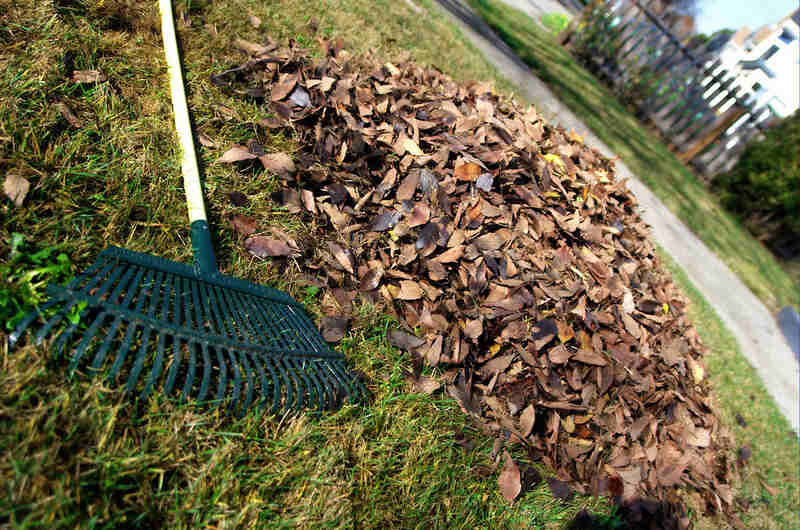
Get rid of the debris around your entire lawn, including fallen leaves, twigs, rocks, etc. You should also move all objects off of your lawn so your fertilizer can reach the soil.
Step 3: Mow Your Lawn
Mow your lawn to the proper height. The proper height for your yard depends on the type of grass you have. Be careful not to mow too low, as this can stress your grass, especially if you’re adding fertilizer right after.
You can check our cool-season grass guide to find the right mowing height for your cool-season lawn. Check our warm-season grass guide to find out the proper mowing height for your warm-season lawn.
Make sure your grass is dry before mowing.
Step 4: Rake Any Grass Clumps
If you’re grasscycling, you need to ensure that your grass clippings are evenly distributed across your lawn. You can use a rake to spread out any clumps of grass. These clumps could block the fertilizer from reaching the soil.
Step 5: Fertilize Your Turf
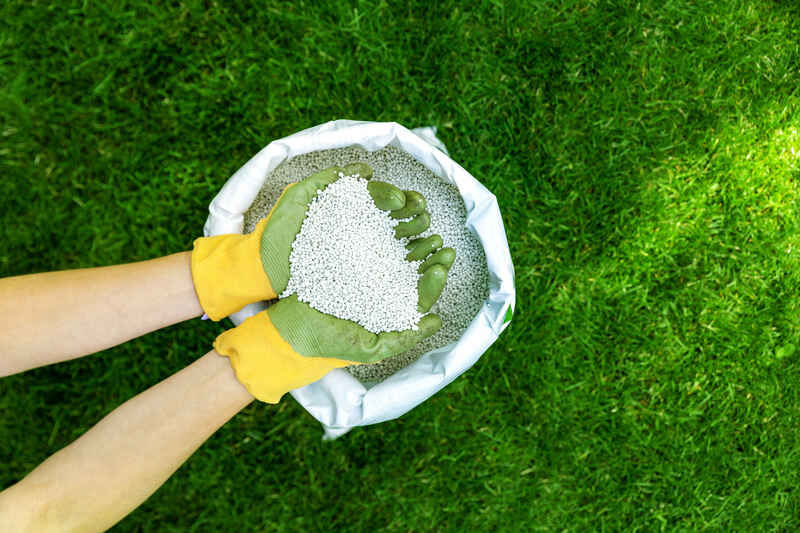
Congratulations! You can now fertilize your turf and foster healthy growth. Always read the instructions for your chosen fertilizer carefully before applying it to the lawn.
It’s better to wait a few hours after mowing before you apply fertilizer to your lawn to minimize nitrogen burn, but doing it in this order ensures that the product won’t be removed from your fertilized lawn.
Types of Fertilizer
There are two types of fertilizer: liquid and granular fertilizer. You can read more about them in our liquid fertilizer vs. granular fertilizer article, but here is some basic information about each kind:
Liquid fertilizer is fertilizer in liquid form, typically mixed with water before being sprayed. It is easier to apply and generally allows for more uniform coverage. It can also be used together with herbicides and pesticides.
However, liquid fertilizer is usually quick-release, which has a higher risk of burning your grass. It is possible to mow the lawn a few hours after applying liquid fertilizer.
Granular fertilizer, on the other hand, is solid, kind of like little grains of dirt. You need a fertilizer spreader to apply the granules, and it has to be watered in. This fertilizer is typically slow-release, so it lasts longer and doesn’t have to be applied as often as liquid fertilizer. It’s also cheaper.
But don’t mow soon after applying granular fertilizer. Always wait at least 24-48 hours to mow the lawn after applying it.
Mowing Tips
When it comes to mowing, just any ol’ pass with the lawn mower won’t cut it. While it seems easy, mowing can end up hurting your lawn when done improperly. Here are a few lawn mowing tips to keep in mind, especially if you’re fertilizing on the same day:
- Don’t use a grass catcher when mowing after fertilizing your lawn. If there’s any leftover fertilizer on the grass, the grass catcher will prevent it from returning to the lawn.
- Don’t mow when the grass is wet. Mowing a wet lawn will give it an uneven cut, and the wet grass can clog your lawn mower blades.
- Mow your grass to the proper height. Mowing too short will stress your lawn out and invite pests and diseases. Nitrogen fertilizer will add to this stress.
- Change your mowing pattern every time you mow so that the lawn maintains an even cut.
- Keep your mower blades sharp because dull blades will actually harm your lawn and possibly turn it yellow or brown.
FAQs About Mowing and Fertilizing on the Same Day
Should You Test Your Soil Before Fertilization?
Yes! A soil test is a great way to find out what nutrients your lawn is missing so you know what fertilizer is best for your lawn. Use the results of a soil test to find out if you need a fertilizer that has more nitrogen, phosphorus, or potassium.
You can also find out if your soil’s pH is too high or too low for your turf; you may need to lime your lawn if the soil is too acidic.
Is There a Difference Between Spring Fertilizers and Fall Fertilizers?
Yes. Spring fertilizers are typically higher in nitrogen to boost new growth, while fall fertilizers are richer in potassium to strengthen grass before the dormant winter season.
When Should You Fertilize Your Lawn?
The first fertilizer application should happen in spring, after the lawn greens up from winter dormancy. After that, the best time of year to fertilize your lawn depends on the type of grass that you have:
- Cool-season grasses like fescues and Kentucky bluegrass should be fertilized in early spring and fall.
- Warm-season grasses like Zoysia, Bermuda, centipede, and St. Augustine should be fertilized in early summer but can also be fertilized in early fall.
This is because you have to fertilize your lawn when your grass is actively growing to get the full effects of the fertilizer.
Should You Aerate Your Lawn Before Fertilizing it?
It’s definitely better to get your lawn aerated before fertilizing it. Aeration helps the fertilizer reach the turf’s root system by loosening hard, compacted soil. You can aerate after fertilizing your lawn, but it won’t be as effective.
When to Hire a Lawn Care Pro
While important, mowing and fertilizing can be time-consuming, especially if you want to do them on the same day. Why not leave the lawn maintenance to a professional lawn care service? You can get a beautifully green lawn without raising a finger. They can even handle weed control, thatch removal, and other aspects of lawn care for you, too.
Main Image Credit: Pixabay